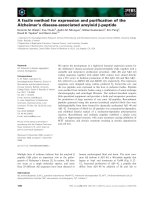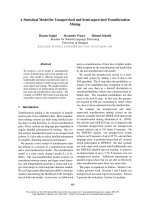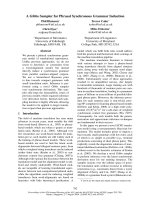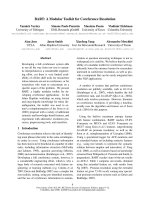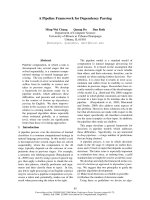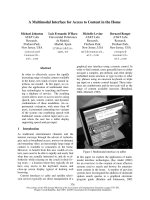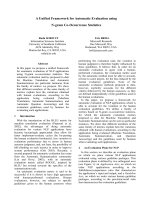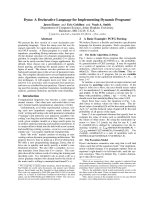Báo cáo khoa học: "A Generalized-Zero-Preserving Method for Compact Encoding of Concept Lattices" pot
Bạn đang xem bản rút gọn của tài liệu. Xem và tải ngay bản đầy đủ của tài liệu tại đây (186.71 KB, 10 trang )
Proceedings of the 48th Annual Meeting of the Association for Computational Linguistics, pages 1512–1521,
Uppsala, Sweden, 11-16 July 2010.
c
2010 Association for Computational Linguistics
A Generalized-Zero-Preserving Method for Compact Encoding of
Concept Lattices
Matthew Skala
School of Computer Science
University of Waterloo
Victoria Krakovna
J
´
anos Kram
´
ar
Dept. of Mathematics
University of Toronto
{vkrakovna,jkramar}@gmail.com
Gerald Penn
Dept. of Computer Science
University of Toronto
Abstract
Constructing an encoding of a concept lat-
tice using short bit vectors allows for ef-
ficient computation of join operations on
the lattice. Join is the central operation
any unification-based parser must support.
We extend the traditional bit vector encod-
ing, which represents join failure using the
zero vector, to count any vector with less
than a fixed number of one bits as failure.
This allows non-joinable elements to share
bits, resulting in a smaller vector size. A
constraint solver is used to construct the
encoding, and a variety of techniques are
employed to find near-optimal solutions
and handle timeouts. An evaluation is pro-
vided comparing the extended representa-
tion of failure with traditional bit vector
techniques.
1 Introduction
The use of bit vectors is almost as old as HPSG
parsing itself. Since they were first suggested in
the programming languages literature (A
¨
ıt-Kaci et
al., 1989) as a method for computing the unifica-
tion of two types without table lookup, bit vectors
have been attractive because of three speed advan-
tages:
• The classical bit vector encoding uses bitwise
AND to calculate type unification. This is
hard to beat.
• Hash tables, the most common alternative,
involve computing the Dedekind-MacNeille
completion (DMC) at compile time if the in-
put type hierarchy is not a bounded-complete
partial order. That is exponential time in the
worst case; most bit vector methods avoid ex-
plicitly computing it.
• With large type signatures, the table that in-
dexes unifiable pairs of types may be so large
that it pushes working parsing memory into
swap. This loss of locality of reference costs
time.
Why isn’t everyone using bit vectors? For the
most part, the reason is their size. The classical
encoding given by A
¨
ıt-Kaci et al. (1989) is at least
as large as the number of meet-irreducible types,
which in the parlance of HPSG type signatures
is the number of unary-branching types plus the
number of maximally specific types. For the En-
glish Resource Grammar (ERG) (Copestake and
Flickinger, 2000), these are 314 and 2474 respec-
tively. While some systems use them nonetheless
(PET (Callmeier, 2000) does, as a very notable ex-
ception), it is clear that the size of these codes is a
source of concern.
Again, it has been so since the very beginning:
A
¨
ıt-Kaci et al. (1989) devoted several pages to
a discussion of how to “modularize” type codes,
which typically achieves a smaller code in ex-
change for a larger-time operation than bitwise
AND as the implementation of type unification.
However, in this and later work on the subject
(e.g. (Fall, 1996)), one constant has been that we
know our unification has failed when the imple-
mentation returns the zero vector. Zero preserva-
tion (Mellish, 1991; Mellish, 1992), i.e., detect-
ing a type unification failure, is just as important
as obtaining the right answer quickly when it suc-
ceeds.
The approach of the present paper borrows
from recent statistical machine translation re-
search, which addresses the problem of efficiently
representing large-scale language models using a
mathematical construction called a Bloom filter
(Talbot and Osborne, 2007). The approach is best
combined with modularization in order to further
reduce the size of the codes, but its novelty lies in
1512
the observation that counting the number of one
bits in an integer is implemented in the basic in-
struction sets of many CPUs. The question then
arises whether smaller codes would be obtained
by relaxing zero preservation so that any resulting
vector with at most λ bits is interpreted as failure,
with λ ≥ 1.
Penn (2002) generalized join-preserving encod-
ings of partial orders to the case where more than
one code can be used to represent the same ob-
ject, but the focus there was on codes arising from
successful unifications; there was still only one
representative for failure. To our knowledge, the
present paper is the first generalization of zero
preservation in CL or any other application do-
main of partial order encodings.
We note at the outset that we are not using
Bloom filters as such, but rather a derandomized
encoding scheme that shares with Bloom filters
the essential insight that λ can be greater than zero
without adverse consequences for the required al-
gebraic properties of the encoding. Deterministic
variants of Bloom filters may in turn prove to be
of some value in language modelling.
1.1 Notation and definitions
A partial order X, consists of a set X and a
reflexive, antisymmetric, and transitive binary re-
lation . We use u v to denote the unique least
upper bound or join of u, v ∈ X, if one exists, and
u v for the greatest lower bound or meet. If we
need a second partial order, we use for its order
relation and for its join operation. We are espe-
cially interested in a class of partial orders called
meet semilattices, in which every pair of elements
has a unique meet. In a meet semilattice, the join
of two elements is unique when it exists at all, and
there is a unique globally least element ⊥ (“bot-
tom”).
A successor of an element u ∈ X is an element
v = u ∈ X such that u v and there is no w ∈ X
with w = u, w = v, and u w v, i.e., v fol-
lows u in X with no other elements in between. A
maximal element has no successor. A meet irre-
ducible element is an element u ∈ X such that for
any v, w ∈ X, if u = v w then u = v or u = w.
A meet irreducible has at most one successor.
Given two partial orders X, and Y, , an
embedding of X into Y is a pair of functions
f : X → Y and g : (Y × Y ) → {0, 1}, which
may have some of the following properties for all
u, v ∈ X:
u v ⇒ f (u) f(v) (1)
defined(u v) ⇒ g(f(u), f(v)) = 1 (2)
¬defined(u v) ⇒ g(f(u), f(v)) = 0 (3)
u v = w ⇔ f (u) f(v) = f(w) (4)
With property (1), the embedding is said to pre-
serve order; with property (2), it preserves suc-
cess; with property (3), it preserves failure; and
with property (4), it preserves joins.
2 Bit-vector encoding
Intuitively, taking the join of two types in a type hi-
erarchy is like taking the intersection of two sets.
Types often represent sets of possible values, and
the type represented by the join really does repre-
sent the intersection of the sets that formed the in-
put. So it seems natural to embed a partial order of
types X, into a partial order (in fact, a lattice)
of sets Y, , where Y is the power set of some
set Z, and is the superset relation ⊇. Then join
is simply set intersection ∩. The embedding
function g, which indicates whether a join exists,
can be naturally defined by g(f (u), f(v)) = 0 if
and only if f(u) ∩ f(v) = ∅. It remains to choose
the underlying set Z and embedding function f .
A
¨
ıt-Kaci et al. (1989) developed what has be-
come the standard technique of this type. They
set Z to be the set of all meet irreducible elements
in X; and f(u) = {v ∈ Z|v u}, that is, the
meet irreducible elements greater than or equal to
u. The resulting embedding preserves order, suc-
cess, failure, and joins. If Z is chosen to be the
maximal elements of X instead, then join preser-
vation is lost but the embedding still preserves or-
der, success, and failure. The sets can be repre-
sented efficiently by vectors of bits. We hope to
minimize the size of the largest set f(⊥), which
determines the vector length.
It follows from the work of Markowsky (1980)
that the construction of A
¨
ıt-Kaci et al. is optimal
among encodings that use sets with intersection
for meet and empty set for failure: with Y defined
as the power set of some set Z, as ⊇, as ∩, and
g(f(u), f(v)) = 0 if and only if f(u) ∩ f(v) = ∅,
then the smallest Z that will preserve order, suc-
cess, failure, and joins is the set of all meet irre-
ducible elements of X. No shorter bit vectors are
possible.
We construct shorter bit vectors by modifying
the definition of g, so that the minimality results
1513
no longer apply. In the following discussion we
present first an intuitive and then a technical de-
scription of our approach.
2.1 Intuition from Bloom filters
Vectors generated by the above construction tend
to be quite sparse, or if not sparse, at least bor-
ing. Consider a meet semilattice containing only
the bottom element ⊥ and n maximal elements all
incomparable to each other. Then each bit vector
would consist of either all ones, or all zeroes ex-
cept for a single one. We would thus be spending
n bits to represent a choice among n + 1 alterna-
tives, which should fit into a logarithmic number
of bits. The meet semilattices that occur in prac-
tice are more complicated than this example, but
they tend to contain things like it as a substruc-
ture. With the traditional bit vector construction,
each of the maximal elements consumes its own
bit, even though those bits are highly correlated.
The well-known technique called Bloom fil-
tering (Bloom, 1970) addresses a similar issue.
There, it is desired to store a large array of bits
subject to two considerations. First, most of the
bits are zeroes. Second, we are willing to accept
a small proportion of one-sided errors, where ev-
ery query that should correctly return one does so,
but some queries that should correctly return zero
might actually return one instead.
The solution proposed by Bloom and widely
used in the decades since is to map the entries in
the large bit array pseudorandomly (by means of
a hash function) into the entries of a small bit ar-
ray. To store a one bit we find its hashed location
and store it there. If we query a bit for which the
answer should be zero but it happens to have the
same hashed location as another query with the an-
swer one, then we return a one and that is one of
our tolerated errors.
To reduce the error rate we can elaborate the
construction further: with some fixed k, we use
k hash functions to map each bit in the large array
to several locations in the small one. Figure 1 il-
lustrates the technique with k = 3. Each bit has
three hashed locations. On a query, we check all
three; they must all contain ones for the query to
return a one. There will be many collisions of indi-
vidual hashed locations, as shown; but the chances
are good that when we query a bit we did not in-
tend to store in the filter, at least one of its hashed
locations will still be empty, and so the query will
1 1 1 1 1
1 1 1
1
?
1
Figure 1: A Bloom filter
return zero. Bloom describes how to calculate the
optimal value of k, and the necessary length of
the hashed array, to achieve any desired bound on
the error rate. In general, the hashed array can
be much smaller than the original unhashed ar-
ray (Bloom, 1970).
Classical Bloom filtering applied to the sparse
vectors of the embedding would create some per-
centage of incorrect join results, which would then
have to be handled by other techniques. Our work
described here combines the idea of using k hash
functions to reduce the error rate, with perfect
hashes designed in a precomputation step to bring
the error rate to zero.
2.2 Modified failure detection
In the traditional bit vector construction, types
map to sets, join is computed by intersection of
sets, and the empty set corresponds to failure
(where no join exists). Following the lead of
Bloom filters, we change the embedding function
g(f(u), f(v)) to be 0 if and only if |f(u)∩f(v)| ≤
λ for some constant λ. With λ = 0 this is the same
as before. Choosing greater values of λ allows us
to re-use set elements in different parts of the type
hierarchy while still avoiding collisions.
Figure 2 shows an example meet semilattice. In
the traditional construction, to preserve joins we
must assign one bit to each of the meet-irreducible
elements {d, e, f, g, h, i, j, k, l, m}, for a total of
ten bits. But we can use eight bits and still pre-
serve joins by setting g(f (u), f(v)) = 0 if and
only if |f(u) ∩ f(v)| ≤ λ = 1, and f as follows.
f(⊥) = {1, 2, 3, 4, 5, 6, 7, 8}
f(a) = {1, 2, 3, 4, 5}
f(b) = {1, 6, 7, 8} f(c) = {1, 2, 3}
f(d) = {2, 3, 4, 5} f(e) = {1, 6}
f(f) = {1, 7} f(g) = {1, 8}
f(h) = {6, 7} f(i) = {6, 8}
f(j) = {1, 2} f(k) = {1, 3}
f(l) = {2, 3} f(m) = {2, 3, 4}
(5)
1514
a
c
d
b
e
f
g
h
i
j k l
m
Figure 2: An example meet semilattice; ⊥ is the
most general type.
As a more general example, consider the very
simple meet semilattice consisting of just a least
element ⊥ with n maximal elements incompara-
ble to each other. For a given λ we can represent
this in b bits by choosing the smallest b such that
b
λ+1
≥ n and assigning each maximal element a
distinct choice of the bits. With optimal choice of
λ, b is logarithmic in n.
2.3 Modules
As A
¨
ıt-Kaci et al. (1989) described, partial or-
ders encountered in practice often resemble trees.
Both their technique and ours are at a disadvantage
when applied to large trees; in particular, if the
bottom of the partial order has successors which
are not joinable with each other, then those will be
assigned large sets with little overlap, and bits in
the vectors will tend to be wasted.
To avoid wasting bits, we examine the partial
order X in a precomputation step to find the mod-
ules, which are the smallest upward-closed sub-
sets of X such that for any x ∈ X, if x has at
least two joinable successors, then x is in a mod-
ule. This is similar to ALE’s definition of mod-
ule (Penn, 1999), but not the same. The definition
of A
¨
ıt-Kaci et al. (1989) also differs from ours.
Under our definition, every module has a unique
least element, and not every type is in a module.
For instance, in Figure 2, the only module has a
as its least element. In the ERG’s type hierarchy,
there are 11 modules, with sizes ranging from 10
to 1998 types.
To find the join of two types in the same mod-
ule, we find the intersection of their encodings and
check whether it is of size greater than λ. If the
types belong to two distinct modules, there is no
join. For the remaining cases, where at least one of
the types lacks a module, we observe that the mod-
ule bottoms and non-module types form a tree, and
the join can be computed in that tree. If x is a type
in the module whose bottom is y, and z has no
module, then x z = y z unless y z = y
in which case x z = x; so it only remains to
compute joins within the tree. Our implementa-
tion does that by table lookup. More sophisticated
approaches could be appropriate on larger trees.
3 Set programming
Ideally, we would like to have an efficient algo-
rithm for finding the best possible encoding of any
given meet semilattice. The encoding can be rep-
resented as a collection of sets of integers (repre-
senting bit indices that contain ones), and an opti-
mal encoding is the collection of sets whose over-
all union is smallest subject to the constraint that
the collection forms an encoding at all. This com-
binatorial optimization problem is a form of set
programming; and set programming problems are
widely studied. We begin by defining the form of
set programming we will use.
Definition 1 Choose set variables S
1
, S
2
, . . . , S
n
to minimize b = |
n
i=1
S
i
| subject to some con-
straints of the forms |S
i
| ≥ r
i
, S
i
⊆ S
j
, S
i
S
j
,
|S
i
∩ S
j
| ≤ λ, and S
i
∩ S
j
= S
k
. The constant
λ is the same for all constraints. Set elements may
be arbitrary, but we generally assume they are the
integers {1 . . . b} for convenience.
The reduction of partial order representation to
set programming is clear: we create a set variable
for every type, force the maximal types’ sets to
contain at least λ + 1 elements, and then use sub-
set to enforce that every type is a superset of all
its successors (preserving order and success). We
limit the maximum intersection of incomparable
types to preserve failure. To preserve joins, if that
property is desired, we add a constraint S
i
S
j
for every pair of types x
i
x
j
and one of the
form S
i
∩ S
j
= S
k
for every x
i
, x
j
, x
k
such that
x
i
x
j
= x
k
Given a constraint satisfaction problem like this
one, we can ask two questions: is there a feasi-
ble solution, assigning values to the variables so
all constraints are satisfied; and if so what is the
optimal solution, producing the best value of the
objective while remaining feasible? In our prob-
lem, there is always a feasible solution we can
find by the generalized A
¨
ıt-Kaci et al. construc-
tion (GAK), which consists of assigning λ bits
1515
shared among all types; adding enough unshared
new bits to maximal elements to satisfy cardinal-
ity constraints; adding one new bit to each non-
maximal meet irreducible type; and propagating
all the bits down the hierarchy to satisfy the subset
constraints. Since the GAK solution is feasible, it
provides a useful upper bound on the result of the
set programming.
Ongoing research on set programming has pro-
duced a variety of software tools for solving these
problems. However, at first blush our instances are
much too large for readily-available set program-
ming tools. Grammars like ERG contain thou-
sands of types. We use binary constraints be-
tween every pair of types, for a total of millions
of constraints—and these are variables and con-
straints over a domain of sets, not integers or re-
als. General-purpose set programming software
cannot handle such instances.
3.1 Simplifying the instances
First of all, we only use minimum cardinality con-
straints |S
i
| ≥ r
i
for maximal types; and every
r
i
≥ λ + 1. Given a feasible bit assignment for a
maximal type with more than r
i
elements in its set
S
i
, we can always remove elements until it has ex-
actly r
i
elements, without violating the other con-
straints. As a result, instead of using constraints
|S
i
| ≥ r
i
we can use constraints |S
i
| = r
i
. Doing
so reduces the search space.
Subset is transitive; so if we have constraints
S
i
⊆ S
j
and S
j
⊆ S
k
, then S
i
⊆ S
k
is implied
and we need not specify it as a constraint. Simi-
larly, if we have S
i
⊆ S
j
and S
i
S
k
, then we
have S
j
S
k
. Furthermore, if S
i
and S
j
have
maximum intersection λ, then any subset of S
i
also has maximum intersection λ with any subset
of S
k
, and we need not specify those constraints
either.
Now, let a choke-vertex in the partial order
X, be an element u ∈ X such that for ev-
ery v, w ∈ X where v is a successor of w and
u v, we have u w. That is, any chain of suc-
cessors from elements not after u to elements after
u, must pass through u. Figure 2 shows choke-
vertices as squares. We call these choke-vertices
by analogy with the graph theoretic concept of
cut-vertices in the Hasse diagram of the partial or-
der; but note that some vertices (like j and k) can
be choke-vertices without being cut-vertices, and
some vertices (like c) can be cut-vertices without
being choke-vertices. Maximal and minimal ele-
ments are always choke-vertices.
Choke-vertices are important because the op-
timal bit assignment for elements after a choke-
vertex u is almost independent of the bit assign-
ment elsewhere in the partial order. Removing
the redundant constraints means there are no con-
straints between elements after u and elements
before, or incomparable with, u. All constraints
across u must involve u directly. As a result, we
can solve a smaller instance consisting of u and
everything after it, to find the minimal number of
bits r
u
for representing u. Then we solve the rest
of the problem with a constraint |S
u
| = r
u
, ex-
cluding all partial order elements after u, and then
combine the two solutions with any arbitrary bi-
jection between the set elements assigned to u in
each solution. Assuming optimal solutions to both
sub-problems, the result is an optimal solution to
the original problem.
3.2 Splitting into components
If we cut the partial order at every choke-vertex,
we reduce the huge and impractical encoding
problem to a collection of smaller ones. The cut-
ting expresses the original partial order as a tree
of components, each of which corresponds to a set
programming instance. Components are shown by
the dashed lines in Figure 2. We can find an op-
timal encoding for the entire partial order by opti-
mally encoding the components, starting with the
leaves of that tree and working our way back to the
root.
The division into components creates a collec-
tion of set programming instances with a wide
range of sizes and difficulty; we examine each in-
stance and choose appropriate techniques for each
one. Table 1 summarizes the rules used to solve an
instance, and shows the number of times each rule
was applied in a typical run with the modules ex-
tracted from ERG, a ten-minute timeout, and each
λ from 0 to 10.
In many simple cases, GAK is provably opti-
mal. These include when λ = 0 regardless of the
structure of the component; when the component
consists of a bottom and zero, one, or two non-
joinable successors; and when there is one element
(a top) greater than all other elements in the com-
ponent. We can easily recognize these cases and
apply GAK to them.
Another important special case is when the
1516
Condition Succ. Fail. Method
λ = 0 216 GAK (optimal)
∃ top 510 GAK (optimal)
2 successors 850 GAK (optimal)
3 or 4
successors
70 exponential
variable
only ULs 420 b-choose-(λ+1)
special case
before UL
removal
251 59 ic_sets
after UL
removal
9 50 ic_sets
remaining 50 GAK
Table 1: Rules for solving an instance in the ERG
component consists of a bottom and some num-
ber k of pairwise non-joinable successors, and the
successors all have required cardinality λ + 1.
Then the optimal encoding comes from finding the
smallest b such that
b
λ+1
is at least k, and giving
each successor a distinct combination of the b bits.
3.3 Removing unary leaves
For components that do not have one of the spe-
cial forms described above, it becomes necessary
to solve the set programming problem. Some of
our instances are small enough to apply constraint
solving software directly; but for larger instances,
we have one more technique to bring them into the
tractable range.
Definition 2 A unary leaf (UL) is an element x in
a partial order X, such that x is maximal and
x is the successor of exactly one other element.
ULs are special because their set programming
constraints always take a particular form: if x is a
UL and a successor of y, then the constraints on
its set S
x
are exactly that |S
x
| = λ + 1, S
x
⊆ S
y
,
and S
x
has intersection of size at most λ with the
set for any other successor of y. Other constraints
disappear by the simplifications described earlier.
Furthermore, ULs occur frequently in the par-
tial orders we consider in practice; and by increas-
ing the number of sets in an instance, they have
a disproportionate effect on the difficulty of solv-
ing the set programming problem. We therefore
implement a special solution process for instances
containing ULs: we remove them all, solve the re-
sulting instance, and then add them back one at a
time while attempting to increase the overall num-
ber of elements as little as possible.
This process of removing ULs, solving, and
adding them back in, may in general produce sub-
optimal solutions, so we use it only when the
solver cannot find a solution on the full-sized prob-
lem. In practical experiments, the solver gener-
ally either produces an optimal or very nearly op-
timal solution within a time limit on the order of
ten minutes; or fails to produce a feasible solu-
tion at all, even with a much longer limit. Testing
whether it finds a solution is then a useful way to
determine whether UL removal is worthwhile.
Recall that in an instance consisting of k ULs
and a bottom, an optimal solution consists of find-
ing the smallest b such that
b
λ+1
is at least k; that
is the number of bits for the bottom, and we can
choose any k distinct subsets of size λ + 1 for the
ULs. Augmenting an existing solution to include
additional ULs involves a similar calculation.
To add a UL x as the successor of an element
y without increasing the total number of bits, we
must find a choice of λ + 1 of the bits already as-
signed to y, sharing at most λ bits with any of y’s
other successors. Those successors are in general
sets of arbitrary size, but all that matters for as-
signing x is how many subsets of size λ + 1 they
already cover. The UL can use any such subset
not covered by an existing successor of y. Our al-
gorithm counts the subsets already covered, and
compares that with the number of choices of λ +1
bits from the bits assigned to y. If enough choices
remain, we use them; otherwise, we add bits until
there are enough choices.
3.4 Solving
For instances with a small number of sets and rela-
tively large number of elements in the sets, we use
an exponential variable solver. This encodes the
set programming problem into integer program-
ming. For each element x ∈ {1, 2, . . . , b}, let
c(x) = {i|x ∈ S
i
}; that is, c(x) represents the
indices of all the sets in the problem that contain
the element x. There are 2
n
− 1 possible values
of c(x), because each element must be in at least
one set. We create an integer variable for each of
those values. Each element is counted once, so the
sum of the integer variables is b. The constraints
translate into simple inequalities on sums of the
variables; and the system of constraints can be
solved with standard integer programming tech-
niques. After solving the integer programming
problem we can then assign elements arbitrarily
1517
to the appropriate combinations of sets.
Where applicable, the exponential variable ap-
proach works well, because it breaks all the sym-
metries between set elements. It also continues to
function well even when the sets are large, since
nothing in the problem directly grows when we
increase b. The wide domains of the variables
may be advantageous for some integer program-
ming solvers as well. However, it creates an in-
teger programming problem of size exponential in
the number of sets. As a result, it is only applica-
ble to instances with a very few set variables.
For more general set programming instances,
we feed the instance directly into a solver de-
signed for such problems. We used the ECL
i
PS
e
logic programming system (Cisco Systems, 2008),
which offers several set programming solvers as
libraries, and settled on the ic sets library. This
is a straightforward set programming solver based
on containment bounds. We extended the solver
by adding a lightweight not-subset constraint, and
customized heuristics for variable and value selec-
tion designed to guide the solver to a feasible so-
lution as soon as possible. We choose variables
near the top of the instance first, and prefer to as-
sign values that share exactly λ bits with exist-
ing assigned values. We also do limited symme-
try breaking, in that whenever we assign a bit not
shared with any current assignment, the choice of
bit is arbitrary so we assume it must be the lowest-
index bit. That symmetry breaking speeds up the
search significantly.
The present work is primarily on the benefits
of nonzero λ, and so a detailed study of gen-
eral set programming techniques would be inap-
propriate; but we made informal tests of several
other set-programming solvers. We had hoped that
a solver using containment-lexicographic hybrid
bounds as described by Sadler and Gervet (Sadler
and Gervet, 2008) would offer good performance,
and chose the ECL
i
PS
e
framework partly to gain
access to its ic hybrid sets implementation of such
bounds. In practice, however, ic hybrid sets gave
consistently worse performance than ic sets (typi-
cally by an approximate factor of two). It appears
that in intuitive terms, the lexicographic bounds
rarely narrowed the domains of variables much un-
til the variables were almost entirely labelled any-
way, at which point containment bounds were al-
most as good; and meanwhile the increased over-
head of maintaining the extra bounds slowed down
the entire process to more than compensate for
the improved propagation. We also evaluated the
Cardinal solver included in ECL
i
PS
e
, which of-
fers stronger propagation of cardinality informa-
tion; it lacked other needed features and seemed
no more efficient than ic sets. Among these
three solvers, the improvements associated with
our custom variable and value heuristics greatly
outweighed the baseline differences between the
solvers; and the differences were in optimization
time rather than quality of the returned solutions.
Solvers with available source code were pre-
ferred for ease of customization, and free solvers
were preferred for economy, but a license for
ILOG CPLEX (IBM, 2008) was available and we
tried using it with the natural encoding of sets as
vectors of binary variables. It solved small in-
stances to optimality in time comparable to that
of ECL
i
PS
e
. However, for medium to large in-
stances, CPLEX proved impractical. An instance
with n sets of up to b bits, dense with pairwise
constraints like subset and maximum intersection,
requires Θ(n
2
b) variables when encoded into in-
teger programming in the natural way. CPLEX
stores a copy of the relaxed problem, with signifi-
cant bookkeeping information per variable, for ev-
ery node in the search tree. It is capable of storing
most of the tree in compressed form on disk, but in
our larger instances even a single node is too large;
CPLEX exhausts memory while loading its input.
The ECL
i
PS
e
solver also stores each set variable
in a data structure that increases linearly with the
number of elements, so that the size of the prob-
lem as stored by ECL
i
PS
e
is also Θ(n
2
b); but the
constant for ECL
i
PS
e
appears to be much smaller,
and its search algorithm stores only incremental
updates (with nodes per set instead of per element)
on a stack as it explores the tree. As a result, the
ECL
i
PS
e
solver can process much larger instances
than CPLEX without exhausting memory.
Encoding into SAT would allow use of the so-
phisticated solvers available for that problem. Un-
fortunately, cardinality constraints are notoriously
difficult to encode in Boolean logic. The obvi-
ous encoding of our problem into CNFSAT would
require O(n
2
bλ) clauses and variables. Encod-
ings into Boolean variables with richer constraints
than CNFSAT (we tried, for instance, the SICS-
tus Prolog clp(FD) implementation (Carlsson et
al., 1997)) generally exhausted memory on much
smaller instances than those handled by the set-
1518
Module n b
0
λ b
λ
mrs_min 10 7 0 7
conj 13 8 1 7
list 27 15 1 11
local_min 27 21 1 10
cat_min 30 17 1 14
individual 33 15 0 15
head_min 247 55 0 55
*
sort
*
247 129 3 107
synsem_min 612 255 0 255
sign_min 1025 489 3 357
mod_relation 1998 1749 6 284
entire ERG 4305 2788 140 985
Table 2: Best encodings of the ERG and its mod-
ules: n is number of types, b
0
is vector length with
λ = 0, and λ is parameter that gives the shortest
vector length b
λ
.
variable solvers, while offering no improvement
in speed.
4 Evaluation
Table 2 shows the size of our smallest encodings
to date for the entire ERG without modularization,
and for each of its modules. These were found
by running the optimization process of the previ-
ous section on Intel Xeon servers with a timeout
of 30 minutes for each invocation of the solver
(which may occur several times per module). Un-
der those conditions, some modules take a long
time to optimize—as much as two hours per tested
value of λ for sign_min. The Xeon’s hyper-
threading feature makes reproducibility of timing
results difficult, but we found that results almost
never improved with additional time allowance be-
yond the first few seconds in any case, so the prac-
tical effect of the timing variations should be min-
imal.
These results show some significant improve-
ments in vector length for the larger modules.
However, they do not reveal the entire story. In
particular, the apparent superiority of λ = 0 for
the synsem_min module should not be taken
as indicating that no higher λ could be better:
rather, that module includes a very difficult set
programming instance on which the solver failed
and fell back to GAK. For the even larger modules,
nonzero λ proved helpful despite solver failures,
because of the bits saved by UL removal. UL re-
moval is clearly a significant advantage, but only
Encoding length time space
Lookup table n/a 140 72496
Modular, best λ 0–357 321 203
Modular, λ = 0 0–1749 747 579
Non-mod, λ = 0 2788 4651 1530
Non-mod, λ = 1 1243 2224 706
Non-mod, λ = 2 1140 2008 656
Non-mod, λ = 9 1069 1981 622
Non-mod, λ = 140 985 3018 572
Table 3: Query performance. Vector length in bits,
time in milliseconds, space in Kbytes.
for the modules where the solver is failing any-
way. One important lesson seems to be that further
work on set programming solvers would be bene-
ficial: any future more capable set programming
solver could be applied to the unsolved instances
and would be expected to save more bits.
Table 3 and Figure 3 show the performance of
the join query with various encodings. These re-
sults are from a simple implementation in C that
tests all ordered pairs of types for joinability. As
well as testing the non-modular ERG encoding for
different values of λ, we tested the modularized
encoding with λ = 0 for all modules (to show the
effect of modularization alone) and with λ cho-
sen per-module to give the shortest vectors. For
comparison, we also tested a simple lookup table.
The same implementation sufficed for all these
tests, by means of putting all types in one mod-
ule for the non-modular bit vectors or no types
in any module for the pure lookup table. The
times shown are milliseconds of user CPU time
to test all join tests (roughly 18.5 million of them),
on a non-hyperthreading Intel Pentium 4 with a
clock speed of 2.66GHz and 1G of RAM, run-
ning Linux. Space consumption shown is the total
amount of dynamically-allocated memory used to
store the vectors and lookup table.
The non-modular encoding with λ = 0 is the
basic encoding of A
¨
ıt-Kaci et al. (1989). As Ta-
ble 3 shows, we achieved more than a factor of
two improvement from that, in both time and vec-
tor length, just by setting λ = 1. Larger values
offered further small improvements in length up to
λ = 140, which gave the minimum vector length
of 985. That is a shallow minimum; both λ = 120
and λ = 160 gave vector lengths of 986, and the
length slowly increased with greater λ.
However, the fastest bit-count on this architec-
1519
1500
2000
2500
3000
3500
4000
4500
5000
0 50 100 150 200
user CPU time (ms)
lambda (bits)
Figure 3: Query performance for the ERG without modularization.
ture, using a technique first published by Weg-
ner (1960), requires time increasing with the num-
ber of nonzero bits it counts; and a similar effect
would appear on a word-by-word basis even if we
used a constant-time per-word count. As a result,
there is a time cost associated with using larger λ,
so that the fastest value is not necessarily the one
that gives the shortest vectors. In our experiments,
λ = 9 gave the fastest joins for the non-modular
encoding of the ERG. As shown in Figure 3, all
small nonzero λ gave very similar times.
Modularization helps a lot, both with λ = 0,
and when we choose the optimal λ per module.
Here, too, the use of optimal λ improves both time
and space by more than a factor of two. Our best
bit-vector encoding, the modularized one with per-
module optimal λ, is only a little less than half
the speed of the lookup table; and this test favours
the lookup table by giving it a full word for every
entry (no time spent shifting and masking bits) and
testing the pairs in a simple two-level loop (almost
purely sequential access).
5 Conclusion
We have described a generalization of conven-
tional bit vector concept lattice encoding tech-
niques to the case where all vectors with λ or fewer
one bits represent failure; traditional encodings are
the case λ = 0. Increasing λ can reduce the over-
all storage space and improve speed.
A good encoding requires a kind of perfect
hash, the design of which maps naturally to con-
straint programming over sets of integers. We
have described a practical framework for solving
the instances of constraint programming thus cre-
ated, in which we can apply existing or future con-
straint solvers to the subproblems for which they
are best suited; and a technique for modularizing
practical type hierarchies to get better value from
the bit vector encodings. We have evaluated the re-
sulting encodings on the ERG’s type system, and
examined the performance of the associated unifi-
cation test. Modularization, and the use of nonzero
λ, each independently provide significant savings
in both time and vector length.
The modified failure detection concept suggests
several directions for future work, including eval-
uation of the new encodings in the context of a
large-scale HPSG parser; incorporation of further
developments in constraint solvers; and the possi-
bility of approximate encodings that would permit
one-sided errors as in traditional Bloom filtering.
References
Hassan A
¨
ıt-Kaci, Robert S. Boyer, Patrick Lincoln, and
Roger Nasr. 1989. Efficient implementation of lat-
tice operations. ACM Transactions on Programming
Languages and Systems, 11(1):115–146, January.
1520
Burton H. Bloom. 1970. Space/time trade-offs in hash
coding with allowable errors. Communications of
the ACM, 13(7):422–426, July.
Ulrich Callmeier. 2000. PET – a platform for ex-
perimentation with efficient HPSG processing tech-
niques. Natural Language Engineering, 6(1):99–
107.
Mats Carlsson, Greger Ottosson, and Bj
¨
orn Carlson.
1997. An open-ended finite domain constraint
solver. In H. Glaser, P. Hartel, and H. Kucken, ed-
itors, Programming Languages: Implementations,
Logics, and Programming, volume 1292 of Lec-
ture Notes in Computer Science, pages 191–206.
Springer-Verlag, September.
Cisco Systems. 2008. ECL
i
PS
e
6.0. Computer soft-
ware. Online />Ann Copestake and Dan Flickinger. 2000. An
open-source grammar development environment
and broad-coverage English grammar using HPSG.
In Proceedings of the Second Conference on Lan-
guage Resources and Evaluation (LREC 2000).
Andrew Fall. 1996. Reasoning with Taxonomies.
Ph.D. thesis, Simon Fraser University.
IBM. 2008. ILOG CPLEX 11. Computer software.
George Markowsky. 1980. The representation of
posets and lattices by sets. Algebra Universalis,
11(1):173–192.
Chris Mellish. 1991. Graph-encodable description
spaces. Technical report, University of Edinburgh
Department of Artificial Intelligence. DYANA De-
liverable R3.2B.
Chris Mellish. 1992. Term-encodable description
spaces. In D.R. Brough, editor, Logic Program-
ming: New Frontiers, pages 189–207. Kluwer.
Gerald Penn. 1999. An optimized prolog encoding of
typed feature structures. In D. De Schreye, editor,
Logic programming: proceedings of the 1999 Inter-
national Conference on Logic Programming (ICLP),
pages 124–138.
Gerald Penn. 2002. Generalized encoding of descrip-
tion spaces and its application to typed feature struc-
tures. In Proceedings of the 40th Annual Meeting of
the Association for Computational Linguistics (ACL
2002), pages 64–71.
Andrew Sadler and Carmen Gervet. 2008. Enhanc-
ing set constraint solvers with lexicographic bounds.
Journal of Heuristics, 14(1).
David Talbot and Miles Osborne. 2007. Smoothed
Bloom filter language models: Tera-scale LMs on
the cheap. In Proceedings of the 2007 Joint Con-
ference on Empirical Methods in Natural Language
Processing and Computational Natural Language
Learning (EMNLP-CoNLL), pages 468–476.
Peter Wegner. 1960. A technique for counting ones
in a binary computer. Communications of the ACM,
3(5):322.
1521
